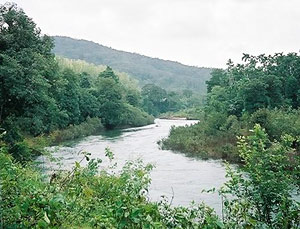 Singhana II was one of the supreme rulers of Yadava dynasty. Singhana laid the foundation of the town called Singhanapur. He wanted to establish an empire in Deccan but the Hoysalas remained as a great impediment. Bichana was an able general and had assisted him in launching a combat against the Hoysala Ballala II in 1211 AD. Vikramaditya of the Sinda family, who was ruling the Kisukad country from his capital Erambarage as a vassal under the Hoysalas, surrendered to Singhana as well. Singhana won Belvola, Huligere, Masavadi, and Hanungal. Vir Vikramaditya II of the Gutla family of Guttal, near Haveri, in the Dharwar district, transferred his allegiance to him. All these conquests brought Singhana to the northern border of the Banavasi country, the capital of which was located at Balligrama, Mysore. The country consisted Nagarkhanda, Jiddulige and Edavatte.
Singhana II was one of the supreme rulers of Yadava dynasty. Singhana laid the foundation of the town called Singhanapur. He wanted to establish an empire in Deccan but the Hoysalas remained as a great impediment. Bichana was an able general and had assisted him in launching a combat against the Hoysala Ballala II in 1211 AD. Vikramaditya of the Sinda family, who was ruling the Kisukad country from his capital Erambarage as a vassal under the Hoysalas, surrendered to Singhana as well. Singhana won Belvola, Huligere, Masavadi, and Hanungal. Vir Vikramaditya II of the Gutla family of Guttal, near Haveri, in the Dharwar district, transferred his allegiance to him. All these conquests brought Singhana to the northern border of the Banavasi country, the capital of which was located at Balligrama, Mysore. The country consisted Nagarkhanda, Jiddulige and Edavatte.
Singhana II soon established his authority over Balligrama also. He advanced towards Bandalike where Ballala gave him a stiff opposition. The Hoysalas surrendered when they found that their grain store was seized by the Sevuna army. By the year 1213 AD Singhana conquered the whole of Banavasi and Santalige and reached the banks of the Tunga River. He marched towards Dorasamudra. Yelavare, son of Malleya-Nayaka, an officer of Ballala, lost his life in an attempt to arrest the advance of army of Singhana. He reached the Kaveri River and defeated Jajalladeva, the ruler of Seringapatam, Mysore.
He also defeated Kakkalla, king of Virata. However he had to eventually withdraw to the north of the Tunga River which formed the southern boundary of his dominion. Singhana directed another mission against the Hoysalas. Two of his generals Vikramapala and Pavusa lost their lives in that engagement.
Singhana II also turned his arms against the petty chiefs of the western coast of Bombay (now Mumbai). The Kadamba Tribhuvanamalla, son of Jayakesi III, king of Gove (Goa), and Karttavirya IV of the Ratta family of Venugrama also surrendered to him. Singhana overthrew Bhoja II and put an end to the rule of the Kolhapur branch of the Silahara family. An Abhira chief named Lakshmideva, ruler of Bhambhagiri, in West Khandesh District, also surrendered to him. Singhana never attempted to capture the territories occupied by Silharas of Northern Konkan. On the south-east he annexed the larger portion of the Anantapur District, Madras State, apparently by defeating the Hoysalas. His attempt to extend his power into the Kakatiya kingdom was foiled by the Kakatiya Ganapati. He reached Chahanda, Madhya Pradesh, where he defeated Paramara Bhoja, who belonged to a minor branch of the Paramara dynasty ruling in that part of the country.
Singhana`s next target were his traditional enemies, the Paramaras of Malwa and the Chalukyas of Gujarat. Singhana, assisted by his Brahmin general Kholesvara, crossed the Tapti River and attacked Bhrigukachchha. Arjuna Varman and his feudatory Sindhuraja fought but were defeated, and the latter lost his life. Army of Sighnana invaded the Gurjara country, which was passing through a crisis under the weak rule of the Chalukya Bhima II. Singhana attacked Lata second time and defeated Sankha, son of Sindhuraja.
Singhana II also led two more expeditions against Gujarat. Lavanaprasada, the Gurjara ruler and his son Viradhavala arranged their army on the bank of the Mahi against Singhana`s army. Lavanaprasada was forced to hurry to the north to meet the invasion of the Maravada chiefs. However Singhana retreated to his own country. His army crossed the Narmada under the leadership of Kholesvara`s son Ram, but was repulsed by the Vaghela chief, and Ram lost his life in the battle. As a consequence Singhana`s aggressive operations in the north ended in signal failure.
Empire of Singhana II
Singhana`s empire included Khandesh up to Shimoga and Anantapur Districts, and from the western coast excluding Northern Konkan up to the eastern parts of Hyderabad and Berar. Nikumbha families of Durgapura, the Sindas of Erambarage, Kadambas of Goa, and Rattas of Venugrama were his vassals. Dennayaka, whose headquarters were at Ambadapura, was his governor of Berar. His officer for the administration of the Sindavadi country was Jagadala Soma Nayaka. He appointed Vankuva Ravuta as the viceroy of the southern countries like Belvola, Huligere, Banavasi and Basavura Mallideva. The governor of Belvola, the Guttas of Guttal, and the Sindas of Banavasi were placed under his supervision.
Singhana II was a king who gave importance to art, learning and culture. The astrologers like Changadeva and Anantadeva received support from him. Shrangadeva wrote a thesis on music titled Sangitaratnakara. He established the college of astronomy to study the work of celebrated astronomer Bhaskaracharya. He also encouraged Changadeva, the Kannada poet. Singhana was a king who made several military conquests as well as patronized art and literature.



















